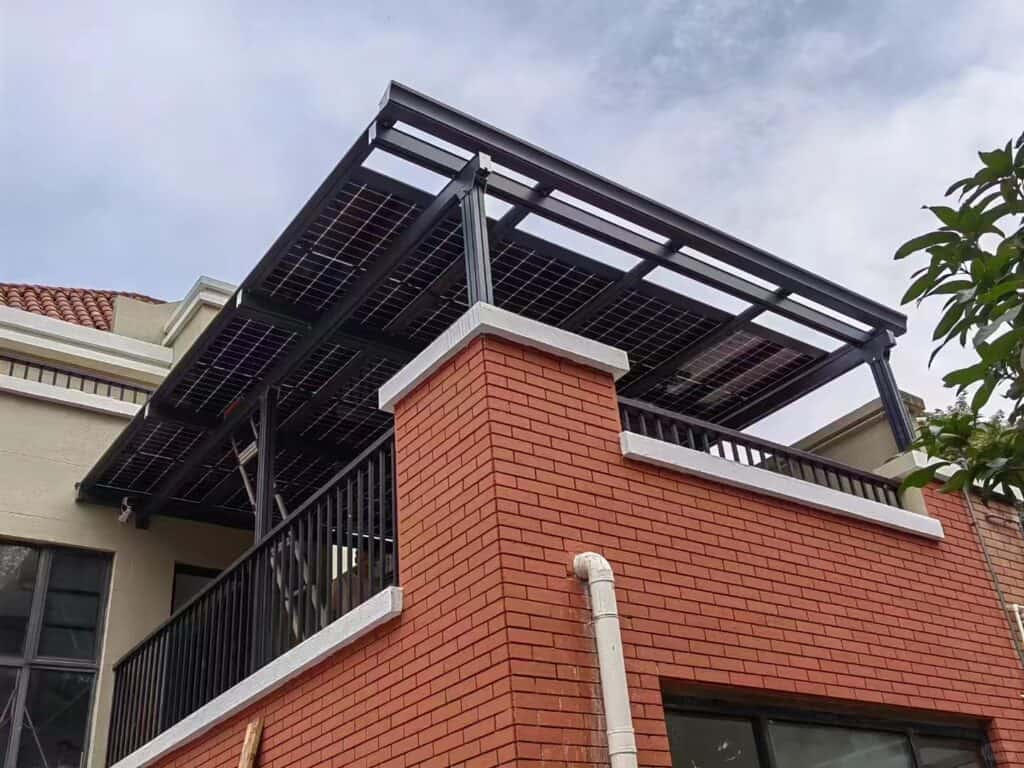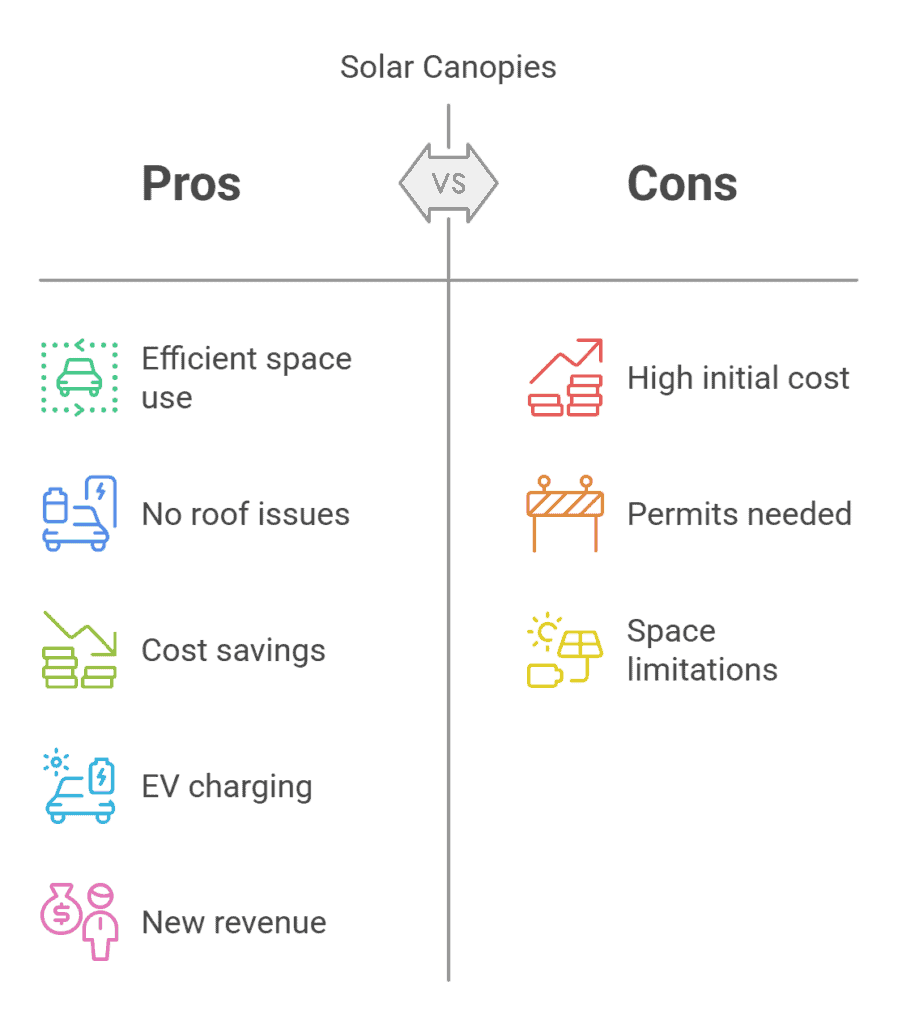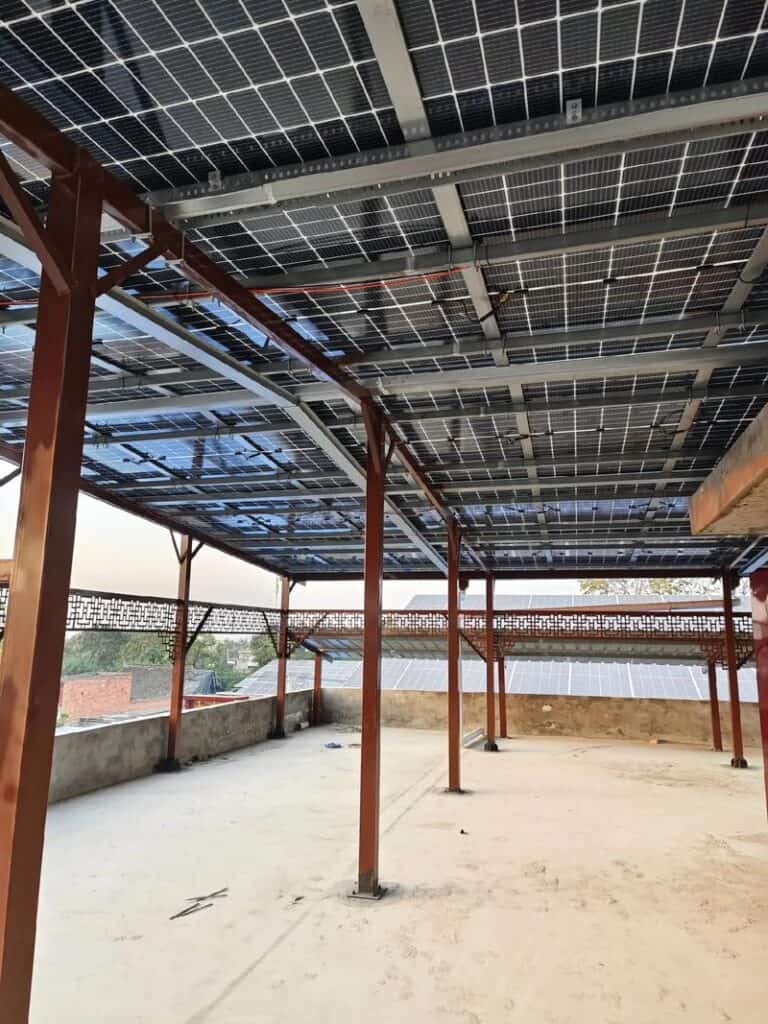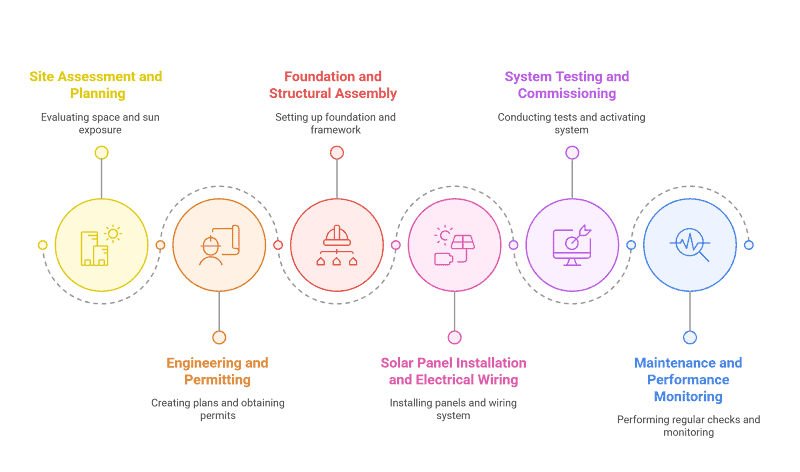A solar canopy is a structure designed to hold solar panels above an open space, such as a parking lot, patio, or walkway. Unlike rooftop solar, it doesn’t require an existing building, making it a flexible solution for generating clean energy while providing shade and weather protection.
With global solar capacity expected to grow by 1,500 GW between 2023 and 2027 (IEA), businesses and homeowners are looking for smarter ways to integrate solar into their spaces. Solar canopies are becoming a go-to solution, especially as energy prices rise and governments offer tax credits and incentives to promote solar adoption.
If you want to cut energy costs, maximize space, and future-proof your property, a solar canopy might be the perfect investment. But how do they work? What are the costs? And how do you choose the right one? In this guide, we’ll break down everything you need to know so you can make an informed decision.
What to Expect in This Blog:
What Is a Solar Canopy?
A solar canopy is a freestanding structure designed to support solar panels while providing shade or protection underneath. Unlike rooftop solar, it does not rely on an existing building, making it a flexible solution for homes, businesses, and public spaces.
Why Is a Solar Canopy Necessary?
Many properties are not suitable for rooftop solar due to:
- Limited roof space or poor orientation for maximum sunlight.
- Structural issues that cannot support solar panels.
- Aesthetic concerns where homeowners prefer not to alter their roof’s appearance.
- Need for multipurpose space, such as shaded parking, outdoor seating, or work areas.
A solar canopy solves these issues by offering an independent, efficient, and space-saving way to generate solar energy while enhancing functionality.

How Does a Solar Canopy Work?
A solar canopy turns sunlight into usable electricity while providing shade or shelter. The process is simple:
- Sunlight Hits the Panels: The solar panels on the canopy absorb sunlight.
- Electricity Is Created: Inside the panels, special materials turn sunlight into electrical energy.
- Power Is Ready to Use: A small device (called an inverter) makes the electricity compatible with your home or business.
- Energy Goes Where You Need It: You can use it right away, store it in batteries, or send it to the grid to save on electricity bills.
Think of it as a solar-powered roof that not only provides shade but also generates electricity for your home, business, or electric vehicle—helping you save money and use clean energy.
What Are the Common Types of Solar Canopies?
Solar canopies come in different forms, depending on their use and location. Here are the most common types:
- Solar Carports (Residential & Commercial) – Built over parking spaces to provide shade while generating electricity. Ideal for homes, businesses, and public parking lots, often integrated with EV charging stations.
- Solar Walkway & Bike Path Canopies – Installed along sidewalks, bike lanes, and pedestrian paths, offering shade and powering streetlights or other infrastructure.
- Solar Bus Shelters – Used at transit stops to provide shade and power lighting, digital displays, and other amenities.
- Solar Rooftop Canopies – Added to the top of commercial buildings or parking garages to generate clean energy while maximizing unused space.
- Solar Pergolas, Gazebos & Patio Covers – Designed for residential and commercial outdoor spaces, combining solar energy generation with aesthetic and functional benefits.
Each type serves the same purpose: turning open spaces into energy-generating areas while enhancing their usability. Your choice depends on whether you need power for a parking area, a transit stop, a walkway, or an outdoor relaxation space.
Related Reading:
What Does a Solar Canopy Do—and Is It Worth It?
What Are the Standard Sizes of Solar Canopies?
Choosing the right size for a solar canopy depends on your space, energy needs, and usage. Here are the common dimensions for different types of solar canopies:
| Type | Typical Width (m/ft) | Typical Length (m/ft) | Height Range (m/ft) | Common Use Case |
| Residential Solar Carports | 3–6 m (10–20 ft) | 5–6 m (16–20 ft) | 2.5–3.5 m (8–12 ft) | Single or double car parking, home EV charging |
| Commercial Solar Carports | 6–12 m (20–40 ft) | 10–30 m (33–100 ft) | 3.5–5 m (12–16 ft) | Business parking lots, fleet charging stations |
| Solar Walkway Canopies | 2–4 m (6–13 ft) | 5–20 m (16–65 ft) | 2.5–4 m (8–13 ft) | Pedestrian pathways, parks, public spaces |
| Solar Bus Shelters | 2–3 m (6–10 ft) | 4–8 m (13–26 ft) | 2.5–3.5 m (8–12 ft) | Public transport stops, urban mobility hubs |
| Solar Pergolas & Gazebos | 3–5 m (10–16 ft) | 3–6 m (10–20 ft) | 2.5–3.5 m (8–12 ft) | Outdoor seating, backyard leisure spaces |
| Rooftop Solar Canopies | Varies based on roof size and available space | Maximizing rooftop energy generation | ||
How to Choose the Right Size? Please Consider:
- How much energy do you need?
Larger canopies hold more solar panels and generate more power. A typical 5m x 6m (16×20 ft) canopy can fit 10–12 solar panels, producing about 3–5 kW of electricity. - What’s your available space?
Ensure enough clearance for cars, pedestrians, and surrounding buildings. - What’s the best height?
Standard residential canopies are 2.5–3.5m (8–12 ft), while commercial setups may require extra clearance. - Are there local restrictions?
Some areas have height limits or zoning laws that affect canopy size.
If you’re unsure about sizing, we offer free 2D & 3D design services to help you visualize your solar canopy before installation.
Pros and Cons of Solar Canopies
Investing in a solar canopy is a smart way to generate clean energy while utilizing outdoor space efficiently. But is it the right choice for you? Let’s look at the key advantages and challenges.

Key Advantages
1. Stop Wasting Space – Turn It into a Power Source
Do you have an unused parking lot, patio, or open space? A solar canopy transforms that dead space into a personal power plant, generating clean energy while providing shade and protection.
- For Homeowners: No need to install panels on your roof—generate solar power without drilling into your home.
- For Businesses: Parking lots are a necessity, why not turn them into a profitable asset that lowers energy costs and creates new revenue streams?
2. No More Roof Problems – A Smarter Solar Alternative
Not every roof is suitable for solar panels. Many homeowners and businesses face challenges like:
- Roof shading issues that reduce solar efficiency.
- Poor orientation that limits energy generation.
- Structural concerns that make installation risky or expensive.
A solar canopy eliminates these limitations, offering the perfect tilt and sun exposure for maximum energy production—without relying on your roof.
3. Slash Electricity Bills & Lock in Energy Savings
Solar canopies significantly cut energy costs, but by how much? Here’s what real savings look like:
- A 20㎡ (215 ft²) solar canopy can generate $1,500+ in electricity savings per year.
- With government incentives and tax credits, many customers recover their investment in just 4–7 years.
- In high-sunlight areas, some customers reach ROI in as little as 4 years.
For businesses, lowering electricity costs means higher profit margins. For homeowners, it means energy independence and lower utility bills for decades.
4. Power Your EV Directly with the Sun
Why pay for charging when you can generate your own clean energy for free? A solar canopy lets you charge your EV during the day, making transportation:
- 100% renewable, reducing reliance on the grid.
- More cost-efficient, saving thousands in fuel expenses over time.
For businesses, solar carports with EV chargers can attract eco-conscious customers and generate additional income by offering charging services.
5. Not Just Savings—Create New Revenue Streams
A solar canopy doesn’t just save money—it can make money. Businesses can:
- Sell excess solar energy back to the grid for additional revenue.
- Monetize parking lots by offering solar-powered EV charging stations.
- Enhance brand reputation by showcasing a visible commitment to sustainability.
Whether you’re looking to reduce expenses, increase property value, or create a new income stream, a solar canopy offers a smart, future-proof investment.
Challenges? We Have the Solutions
1. Higher Initial Cost? It Pays for Itself
Some people worry that solar canopies cost more than rooftop solar due to the structure and installation. But here’s the reality:
- Government tax credits and rebates can reduce upfront costs by 30% or more.
- With the right system, most customers see a return on investment (ROI) in just 4–7 years.
- Long-term electricity savings can exceed $20,000 over 25 years.
2. Permits & Engineering? We’ve Got It Covered
Some locations require permits and zoning approvals for solar canopies. The structure also needs to handle wind, snow, and local building codes.
- We handle everything for you—from structural design to local compliance.
- Free site assessment to ensure your canopy meets all regulations before installation.
3. Not Enough Space? We Have Flexible Options
Worried you don’t have enough space for a full-size solar canopy? No problem.
- Compact solar pergolas & patio covers provide clean energy without taking up too much room.
- Rooftop-mounted solar canopies work great for urban areas and small commercial spaces.
Design Considerations for a Solar Canopy
A well-designed solar canopy is not just about mounting solar panels—it requires careful planning to ensure maximum efficiency, durability, and cost-effectiveness. Here are the key factors to consider when designing your solar canopy.

Structural Types: Fixed, Adjustable, and Cantilever Canopies
Solar canopies come in three main structural types:
- Fixed-tilt canopies – Designed for low-maintenance and cost efficiency. The tilt angle is optimized based on latitude to maximize year-round solar gain.
- Adjustable-tilt canopies – Use mechanical or tracking systems to adjust the panel angle throughout the day, improving energy yield but requiring higher upfront investment and maintenance.
- Cantilever canopies – Ideal for commercial parking lots, reducing the number of columns and maximizing open space. This structure requires stronger beams and foundation support to counterbalance the overhanging load.
Material Selection: Strength, Corrosion Resistance, and Longevity
Selecting the right material is crucial for the lifespan and maintenance requirements of a solar canopy:
- Steel (Hot-Dip Galvanized or Powder-Coated) – Best for large-scale installations, offering superior strength and wind resistance. Galvanization prevents rust, while powder coating enhances durability.
- Aluminum (6061-T6 or 5052-H32) – Lightweight and naturally corrosion-resistant, ideal for residential pergolas and small-scale projects.
For high-humidity or coastal regions, we recommend marine-grade coatings or stainless steel to prevent corrosion over time.
Optimizing Tilt Angle and Sun Orientation
To maximize solar output, the ideal tilt angle depends on your location:
- Latitudes 0-15° → Tilt at 10°
- Latitudes 15-30° → Tilt at 15-20°
- Latitudes 30-45° → Tilt at 25-35°
For EV charging stations, a lower tilt angle (5-10°) may be used to minimize wind resistance and ensure structural stability.
Structural Load Considerations: Wind, Snow, and Seismic Resistance
A properly designed solar canopy must withstand regional environmental loads:
- Wind Load – High-wind areas require aerodynamic structures and reinforced steel beams to prevent uplift.
- Snow Load – In snowy regions, steeper tilt angles (≥35°) help prevent snow accumulation, reducing excess weight on the structure.
- Seismic Load – In earthquake-prone zones, foundations must be reinforced to absorb ground movement and prevent structural failure.
Our designs comply with ASCE 7-22 and Eurocode 3, ensuring compliance with local building standards and extreme weather conditions.
Grid Integration and Battery Storage Options
The generated solar energy can be utilized in different ways:
- Grid-Tied Systems – The most common choice, allowing businesses and homeowners to sell excess energy back to the grid.
- Battery Storage Systems – Offers backup power during grid outages, recommended for EV charging stations and off-grid installations.
For commercial applications, integrating a smart energy management system (EMS) helps optimize power distribution and minimize energy waste.
Related Reading:
Solar Canopy Design: Everything You Need to Know
Factors Affecting the Cost of a Solar Canopy
The cost of a solar canopy depends on several factors, including size, materials, installation complexity, and additional features. Understanding these will help you plan your budget and make cost-effective decisions.

Which Factors Impact Cost the Most?
The three biggest cost factors are:
- Size of the canopy – The larger the structure, the more materials and labor are required.
- Type of materials – Steel is more affordable for large projects, while aluminum offers durability at a higher cost.
- Installation complexity – Terrain, local regulations, and structural reinforcements can increase labor expenses.
Size and Scale of the Canopy
Larger solar canopies cost more because they need more solar panels, stronger support structures, and more labor to install.
- Small residential solar canopies (patio covers, carports): Typically $5,000–$15,000, depending on material and panel efficiency.
- Medium commercial canopies (parking lots, walkways): Range from $20,000–$50,000, requiring reinforced frames.
- Large industrial-scale canopies: Can exceed $100,000, as they require custom engineering and high-capacity solar arrays.
For businesses, large-scale canopies are a long-term investment, often paying for themselves within 4–7 years through electricity savings and government incentives.
Material Selection: Steel vs. Aluminum
The frame material affects both cost and durability.
- Steel (hot-dip galvanized or powder-coated):
- Best for: Large commercial & industrial canopies.
- Pros: Stronger, more cost-effective for large spans.
- Cons: Requires corrosion protection in humid areas.
- Cost: More affordable than aluminum but heavier to transport.
- Aluminum (lightweight & rust-resistant):
- Best for: Small residential canopies or coastal areas.
- Pros: Naturally corrosion-resistant, lower maintenance.
- Cons: Higher upfront cost per unit.
- Cost: More expensive but lasts longer in harsh environments.
For long-term durability, steel with a corrosion-resistant coating is the best value for large-scale projects, while aluminum is ideal for smaller, premium installations.
Type and Efficiency of Solar Panels
Solar panels vary in price, efficiency, and long-term energy output.
- Monocrystalline panels:
- Most efficient (18-22%), last 25+ years.
- Higher upfront cost but more savings over time.
- Polycrystalline panels:
- Lower efficiency (16-18%), lower cost.
- A good budget-friendly option for large-scale installations.
- Bifacial solar panels:
- Capture sunlight from both sides, increasing power generation.
- Higher initial cost, but great for open areas with reflected light.
If maximizing energy output is a priority, monocrystalline or bifacial panels are worth the extra cost.
Installation Complexity and Labor Costs
The cost of installation depends on site conditions and project difficulty.
- Flat, paved surfaces (like parking lots) are easier to build on.
- Uneven terrain requires extra foundation work, increasing costs.
- Wind, snow, and earthquake zones need stronger support structures.
- Taller canopies or cantilever designs require specialized engineering.
For remote areas, transportation and labor availability may add to the total cost. Planning ahead helps avoid unexpected expenses.
Electrical Components and System Integration
Beyond the solar panels and structure, the electrical system also affects cost.
- Grid-tied systems:
- Directly connect to the power grid.
- Lower initial cost, but relies on local grid policies.
- Battery storage systems:
- Store excess power for night use or power outages.
- Higher cost but provides energy independence.
- EV charging stations:
- Adds convenience but requires extra wiring and transformers.
- Businesses can generate revenue by offering paid charging services.
Adding battery storage or EV chargers increases upfront costs but can provide long-term financial benefits.
Permitting and Engineering Costs
Every project must follow local regulations, which can add costs for permits, engineering reviews, and structural assessments.
- Some areas require soil testing before installing the canopy.
- Commercial projects may need wind, snow, and seismic load certifications.
- Local utility companies may charge for grid connection approvals.
Our team provides free site assessments to help ensure compliance and avoid costly delays.
Transportation and Logistics
Shipping large steel components can be costly, especially for international projects. Factors that affect logistics costs:
- Distance from the manufacturing facility.
- Special handling for oversized beams or pre-assembled structures.
- Custom packaging to prevent damage in transit.
For international projects, bulk shipping and modular designs can reduce costs.
Government Incentives and Tax Credits
One of the best ways to reduce the cost of a solar canopy is to take advantage of government incentives.
- Many regions offer solar tax credits, rebates, and grants that can reduce total costs by 30% or more.
- Businesses can use accelerated depreciation to recover investment costs faster.
- Some areas allow selling excess electricity back to the grid, creating an extra revenue stream.
Checking available incentives before installation can help maximize savings.
Which Costs Matter Most to You?
For homeowners, focus on solar panel efficiency and government rebates to shorten the payback period. A well-designed canopy can pay for itself in 5–7 years.
For businesses, larger projects can take advantage of tax credits, energy sales, and EV charging revenue, making it a profitable long-term investment.
How to Install a Solar Canopy: Key Steps and Considerations
Installing a solar canopy is a structured process that requires careful planning and execution. While specific details depend on the project size and location, here’s a high-level overview of the key steps involved.

1. Site Assessment and Planning
Before installation, a site survey is conducted to evaluate available space, sun exposure, and structural requirements. Engineers assess factors like soil conditions, wind load, and local zoning laws to determine the best canopy design.
- For homeowners, this step ensures the canopy fits their space and energy needs.
- For businesses, it helps optimize large-scale installations for maximum efficiency.
2. Engineering and Permitting
After the site assessment, detailed engineering plans are created, specifying:
- Structural design (materials, dimensions, load-bearing capacity).
- Electrical layout (solar panels, inverters, battery storage, if applicable).
- Compliance with local building codes and utility regulations.
Once finalized, these plans are submitted for permits and approvals before construction begins.
3. Foundation and Structural Assembly
The foundation type depends on soil conditions and canopy size. Options include:
- Concrete footings for permanent stability.
- Ground anchors for easier installation on soft surfaces.
Once the foundation is set, the steel or aluminum framework is assembled, ensuring structural integrity and alignment.
4. Solar Panel Installation and Electrical Wiring
With the canopy frame in place, solar panels are mounted and secured. The electrical system is then installed, including:
- Inverters to convert solar energy into usable power.
- Wiring and connections to link the system to the grid or battery storage.
- EV charging stations (if applicable) for direct solar-powered vehicle charging.
5. System Testing and Commissioning
Before activation, the system undergoes final inspections and testing to ensure:
- Panels are positioned for optimal sunlight exposure.
- Electrical connections meet safety and efficiency standards.
- The system integrates smoothly with the power grid or backup storage.
Once approved, the solar canopy is activated, and the owner begins generating clean energy.
6. Maintenance and Performance Monitoring
Solar canopies require minimal maintenance, but regular checks help ensure optimal performance. Key tasks include:
- Cleaning the panels to remove dust and debris.
- Inspecting wiring and connections for wear and tear.
- Monitoring energy output to detect any efficiency drops.
Advanced solar systems include remote monitoring tools, allowing real-time tracking of energy production and system health.
Stop Paying for Expensive Electricity—Turn Your Space into a Solar Asset
Every month you wait, you’re losing money on high energy bills. With solar incentives still available and electricity costs rising, now is the best time to act. Whether you’re a homeowner looking to cut expenses or a business aiming to turn parking spaces into a profit-generating energy source, a solar canopy can start paying for itself in just a few years.
What’s Holding You Back? Let’s Make It Simple.
Not sure if a solar canopy is right for you? Let’s talk. Tell us about your space, and in 15 minutes, we’ll help you figure out:
- How much you could save on energy bills every year.
- What government incentives you qualify for—before they expire.
- How much a solar canopy would cost for your site.
Get a Free, No-Obligation Consultation—Just One Step to Start Saving
Our team takes care of everything—from design and engineering to shipping and installation support. No hassle, no pressure—just clear answers.Limited project slots available this quarter. Contact us today to lock in your savings.

